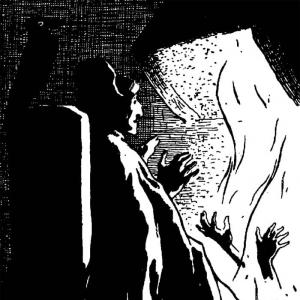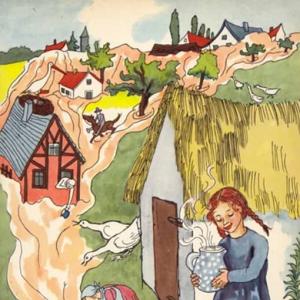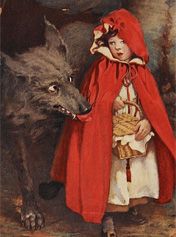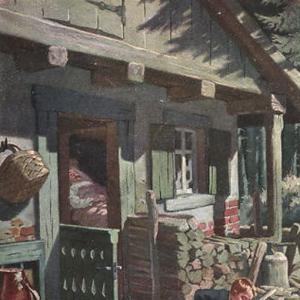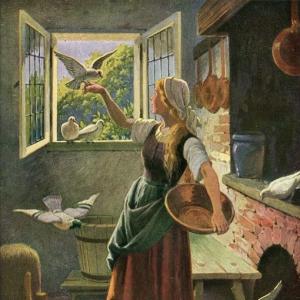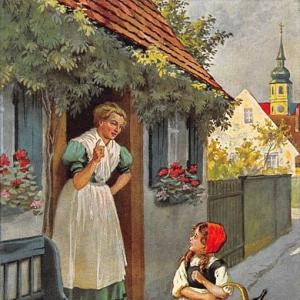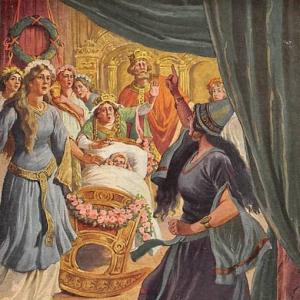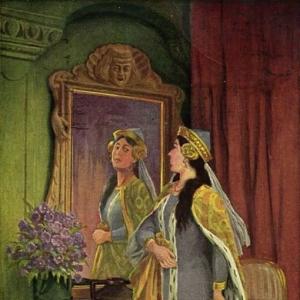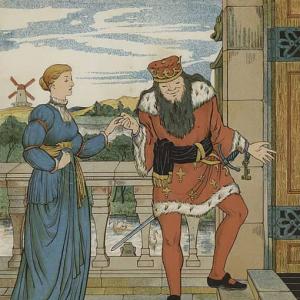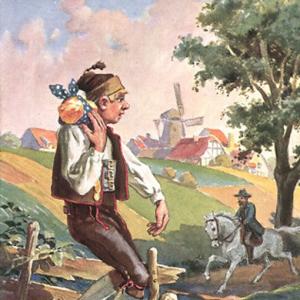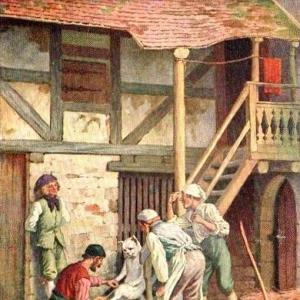Reading time: 8 min
It was terribly cold and nearly dark on the last evening of the old year, and the snow was falling fast. In the cold and the darkness, a poor little girl, with bare head and naked feet, roamed through the streets. It is true she had on a pair of slippers when she left home, but they were not of much use. They were very large, so large, indeed, that they had belonged to her mother, and the poor little creature had lost them in running across the street to avoid two carriages that were rolling along at a terrible rate. One of the slippers she could not find, and a boy seized upon the other and ran away with it, saying that he could use it as a cradle, when he had children of his own.
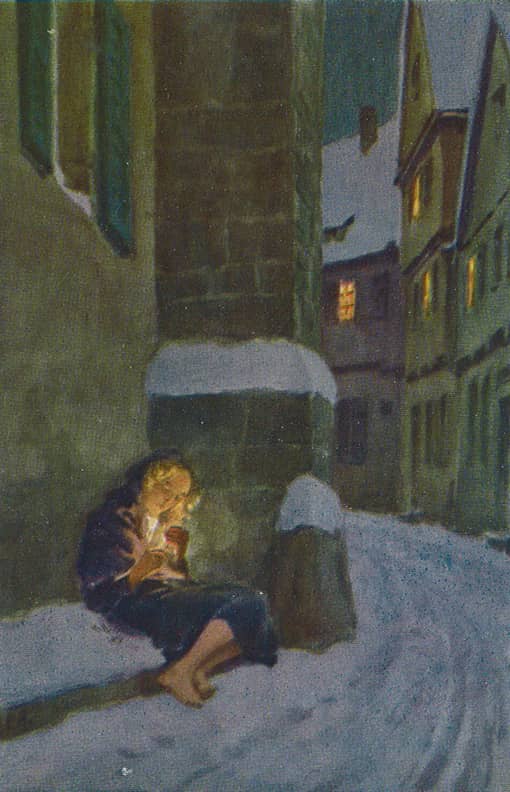 Image: Paul Hey (1867 – 1952)
Image: Paul Hey (1867 – 1952)So the little girl went on with her little naked feet, which were quite red and blue with the cold. In an old apron she carried a number of matches, and had a bundle of them in her hands. No one had bought anything of her the whole day, nor had any one given here even a penny. Shivering with cold and hunger, she crept along; poor little child, she looked the picture of misery. The snowflakes fell on her long, fair hair, which hung in curls on her shoulders, but she regarded them not.
Lights were shining from every window, and there was a savory smell of roast goose, for it was New-year’s eve– yes, she remembered that. In a corner, between two houses, one of which projected beyond the other, she sank down and huddled herself together. She had drawn her little feet under her, but she could not keep off the cold; and she dared not go home, for she had sold no matches, and could not take home even a penny of money. Her father would certainly beat her; besides, it was almost as cold at home as here, for they had only the roof to cover them, through which the wind howled, although the largest holes had been stopped up with straw and rags. Her little hands were almost frozen with the cold. Ah! perhaps a burning match might be some good, if she could draw it from the bundle and strike it against the wall, just to warm her fingers. She drew one out-„scratch!“ how it sputtered as it burnt! It gave a warm, bright light, like a little candle, as she held her hand over it. It was really a wonderful light. It seemed to the little girl that she was sitting by a large iron stove, with polished brass feet and a brass ornament. How the fire burned! and seemed so beautifully warm that the child stretched out her feet as if to warm them, when, lo! the flame of the match went out, the stove vanished, and she had only the remains of the half-burnt match in her hand.
She rubbed another match on the wall. It burst into a flame, and where its light fell upon the wall it became as transparent as a veil, and she could see into the room. The table was covered with a snowy white table-cloth, on which stood a splendid dinner service, and a steaming roast goose, stuffed with apples and dried plums. And what was still more wonderful, the goose jumped down from the dish and waddled across the floor, with a knife and fork in its breast, to the little girl. Then the match went out, and there remained nothing but the thick, damp, cold wall before her.
She lighted another match, and then she found herself sitting under a beautiful Christmas-tree. It was larger and more beautifully decorated than the one which she had seen through the glass door at the rich merchant’s. Thousands of tapers were burning upon the green branches, and colored pictures, like those she had seen in the show-windows, looked down upon it all. The little one stretched out her hand towards them, and the match went out.
The Christmas lights rose higher and higher, till they looked to her like the stars in the sky. Then she saw a star fall, leaving behind it a bright streak of fire. „Some one is dying,“ thought the little girl, for her old grandmother, the only one who had ever loved her, and who was now dead, had told her that when a star falls, a soul was going up to God.
She again rubbed a match on the wall, and the light shone round her. In the brightness stood her old grandmother, clear and shining, yet mild and loving in her appearance. „Grandmother,“ cried the little one, „O take me with you. I know you will go away when the match burns out. You will vanish like the warm stove, the roast goose, and the large, glorious Christmas-tree.“ And she made haste to light the whole bundle of matches, for she wished to keep her grandmother there.
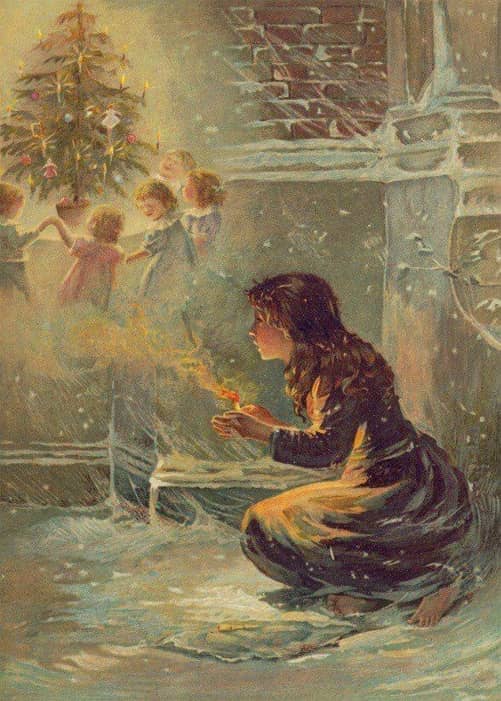 E. Stuart Hardy (1865 – 1935)
E. Stuart Hardy (1865 – 1935)And the matches glowed with a light that was brighter than the noon-day, and her grandmother had never appeared so large or so beautiful. She took the little girl in her arms, and they both flew upwards in brightness and joy far above the earth, where there was neither cold nor hunger nor pain, for they were with God.
In the dawn of morning there lay the poor little one, with pale cheeks and smiling mouth, leaning against the wall. She had been frozen to death on the last evening of the year; and the New-year’s sun rose and shone upon a little corpse! The child still sat, in the stiffness of death, holding the matches in her hand, one bundle of which was burnt. „She tried to warm herself,“ said some. No one imagined what beautiful things she had seen, nor into what glory she had entered with her grandmother, on New-year’s day.
 Learn languages. Double-tap on a word.Learn languages in context with Childstories.org and Deepl.com.
Learn languages. Double-tap on a word.Learn languages in context with Childstories.org and Deepl.com.Backgrounds
Interpretations
Adaptions
Summary
Linguistics
„The Little Match-Seller,“ also known as „The Little Match Girl,“ is a short story by Danish author Hans Christian Andersen. First published in 1845, the story is part of Andersen’s larger collection of fairy tales that includes other famous works such as „The Ugly Duckling,“ „The Little Mermaid,“ and „The Emperor’s New Clothes.“
Hans Christian Andersen (1805-1875) was a Danish author and poet who gained widespread recognition for his literary contributions, particularly his fairy tales. His stories were often inspired by Danish folklore, personal experiences, and observations of the world around him. Many of Andersen’s tales feature moral lessons and address social issues, reflecting his sensitivity to the human condition and his awareness of the societal problems of his time.
„The Little Match-Seller“ is set during the industrial era in the 19th century, a period characterized by significant social and economic changes across Europe. The story reflects the harsh living conditions of the lower classes during this time, particularly the struggles faced by the urban poor. The tale has been adapted into various forms, including films, stage plays, and animated features, and it remains a powerful and poignant story that continues to touch readers and audiences around the world.
„The Little Match-Seller“ is a heart-rending story that has inspired various interpretations. Some of the common interpretations include.
Commentary on social inequality: The story highlights the plight of the poor and the social inequality prevailing during the time. The little girl’s suffering and her visions of warmth, comfort, and abundance emphasize the stark contrast between her reality and the lives of the wealthy. This interpretation calls for empathy, compassion, and awareness of the struggles faced by the less fortunate.
The power of imagination: The girl’s ability to momentarily escape her harsh reality through her vivid imagination highlights the power of the human mind. As she lights each match, she creates a world filled with warmth, joy, and love, demonstrating how imagination can offer solace during difficult times.
The importance of love and human connection: The story emphasizes the need for love and human connection in our lives. The little girl’s grandmother is the only person who ever loved her, and it is through the memory of that love that she finds solace and, ultimately, her eternal reward in the afterlife.
Hope and the promise of a better life: The tale carries a message of hope, as the little girl’s suffering comes to an end when she is reunited with her grandmother. The story suggests that even in the most challenging circumstances, there is the possibility of finding relief and, in this case, eternal happiness in the afterlife.
A critique of society’s indifference: The reactions of the passersby when they find the girl’s lifeless body indicate the indifference of society to the struggles of the poor. This interpretation challenges the readers to reflect on their own actions and attitudes towards those in need, encouraging them to be more understanding and supportive.
Overall, „The Little Match-Seller“ is a moving and thought-provoking tale that carries multiple layers of meaning, emphasizing themes such as social inequality, imagination, love, hope, and the importance of compassion and empathy.
„The Little Match-Seller“ by Hans Christian Andersen has been adapted into various forms of media, including films, TV shows, and plays. Here are some notable adaptations:
Animated Films: The story has been adapted into several animated films, including a 1928 silent film by Jean Renoir and a 2006 Russian film by Mikhail Aldashin.
Live-Action Films: In 1953, a live-action film adaptation of the story was released in Denmark, titled „Den Lille Pige med Svovlstikkerne.“ It has since been adapted into several other films, including a 1990 British film titled „The Little Match Girl.“
Opera: The story has been adapted into an opera by the composer Helmut Lachenmann. The opera premiered in Hamburg, Germany, in 1997.
Ballet: In 1995, a ballet adaptation of the story was created by the choreographer Mats Ek. It has since been performed by several ballet companies worldwide.
Children’s Books: The story has been adapted into numerous children’s books, including a 1987 version illustrated by Jerry Pinkney and a 2018 version illustrated by Rachel Isadora.
Musical Theater: The story has been adapted into a musical titled „Match Girl“ by the composer Stephen Schwartz and the librettist David Stern. It premiered in New York City in 2006.
These adaptations have brought the story to new audiences and explored different interpretations of its themes and messages.
„The Little Match-Seller“ is a poignant fairy tale by Hans Christian Andersen about a poor little girl who ventures out into the freezing cold on New Year’s Eve to sell matches. With her feet bare and her hair covered in snow, the girl fails to sell any matches and, afraid of her father’s anger, does not return home. Instead, she seeks shelter between two houses.
In an attempt to warm herself, the girl lights a match and is momentarily transported to a cozy scene with a glowing stove. As the match goes out, the vision disappears, and she is left cold and alone again. She lights another match, and this time, she sees a warm room with a table set for a feast, complete with a roast goose that comes to life and approaches her. When the match goes out, she is left cold and hungry.
The girl lights a third match, finding herself under a magnificent Christmas tree. She reaches for the tree decorations but, as the match goes out, they fade away. Remembering her late grandmother’s words about stars falling when someone dies, the girl lights another match, and her grandmother appears before her. Desperate to stay with her grandmother, the girl lights the remaining matches, illuminating the scene more brightly than ever.
Her grandmother embraces her, and together they ascend to heaven, free from the cold, hunger, and pain of earthly life. The next morning, the little girl is found frozen to death, still holding the burnt matches. While passersby note her attempts to warm herself, they are unaware of the beautiful visions she experienced and the loving reunion with her grandmother in the afterlife.
The linguistic analysis of Hans Christian Andersen’s „The Little Match-Seller“ can be broken down into several key elements, including narrative style, language use, imagery, and themes.
Here’s an analysis of each:
Narrative Style
Third-Person Perspective: The story is told from a third-person point of view, which allows the narrator to present the little match-seller’s thoughts and emotions while maintaining an omniscient perspective. This approach helps create an empathic connection between the reader and the protagonist while providing a broader view of her surroundings.
Direct and Simple Language: Andersen uses straightforward language with simple sentence structures which make the story accessible to readers of all ages. The simplicity does not detract from the emotional depth; instead, it amplifies the poignancy and stark reality of the little girl’s situation.
Language Use
Descriptive Imagery: The language is rich in descriptive imagery, particularly in depicting the harshness of the environment („terribly cold,“ „naked feet,“ „red and blue with the cold“) and contrasting visions of warmth and comfort („large iron stove,“ „splendid dinner service,“ „beautiful Christmas-tree“). This contrast highlights the gulf between the girl’s dire reality and her hopeful fantasies.
Repetition for Emphasis: Certain phrases and words are repeated (such as „cold“ and „matches“), underscoring the central elements of the girl’s circumstances and sustaining the narrative focus on her struggle and aspirations.
Imagery
Cold vs. Warmth: The narrative consistently juxtaposes the biting cold of the real world against the warmth and joy in the girl’s visions, using sensory details to enhance the emotional impact. This contrast is pivotal, emphasizing her longing for comfort, security, and love.
Light and Darkness: Light in the story is both literal and metaphorical. The matches provide brief moments of light that illuminate the girl’s dreams, representing hope and escape from her dark, cold reality. Darkness symbolizes her harsh life, poverty, and the inevitability of death.
Themes
Poverty and Suffering: The tale starkly portrays the struggles of the impoverished, highlighting the neglect and lack of compassion experienced by those who are most vulnerable. The girl’s plight evokes sympathy and serves as a critique of societal indifference to poverty.
Hope and Escapism: Despite her dire circumstances, the little girl’s imagination allows her small moments of solace. Her visions signify the universal human desire to escape suffering and find joy, love, and comfort, even if they are fleeting.
Death and Transcendence: The ending suggests transcendence of earthly suffering through death. The beautiful visions and the presence of her grandmother symbolize the peace and happiness she achieves in the afterlife, a common theme in Andersen’s tales which often blend melancholia with spiritual redemption.
Innocence and Beauty: The little match-seller’s purity and innocence are emphasized through her visions and her gentle acceptance of her fate. Her innocence contrasts with the coldness of the world around her, highlighting her beauty and vulnerability.
Andersen’s „The Little Match-Seller“ leverages simple yet evocative language to tell a tragic story that is rich in imagery and layered with themes of suffering, hope, and transcendence. The use of contrasts in the narrative reinforces the emotional depth, making it a timeless and poignant tale.
Information for scientific analysis
Fairy tale statistics | Value |
|---|---|
| Translations | DE, EN, EN, EL, DA, ES, FR, IT, NL, RO |
| Readability Index by Björnsson | 31.4 |
| Flesch-Reading-Ease Index | 80.4 |
| Flesch–Kincaid Grade-Level | 7 |
| Gunning Fog Index | 9.6 |
| Coleman–Liau Index | 8.4 |
| SMOG Index | 8.3 |
| Automated Readability Index | 8 |
| Character Count | 5.311 |
| Letter Count | 4.117 |
| Sentence Count | 50 |
| Word Count | 1.000 |
| Average Words per Sentence | 20,00 |
| Words with more than 6 letters | 114 |
| Percentage of long words | 11.4% |
| Number of Syllables | 1.254 |
| Average Syllables per Word | 1,25 |
| Words with three Syllables | 39 |
| Percentage Words with three Syllables | 3.9% |
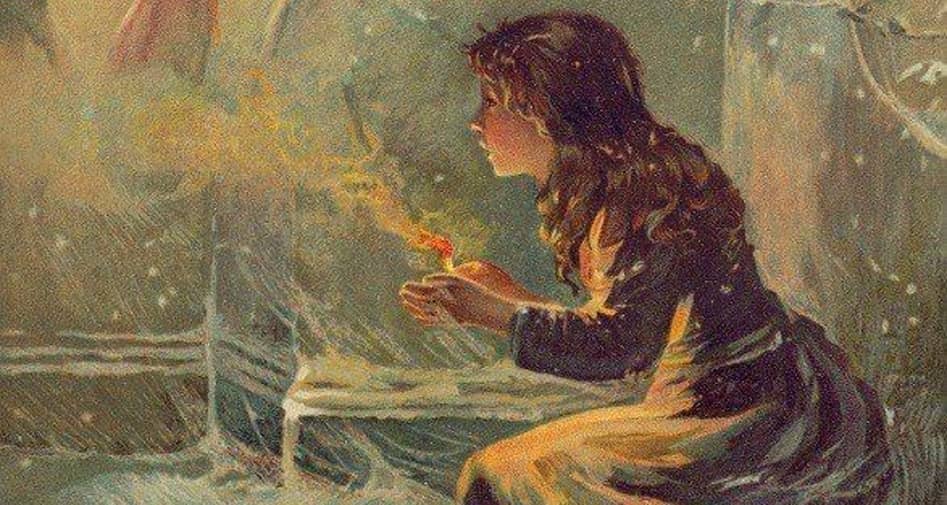
 Facebook
Facebook  Whatsapp
Whatsapp  Messenger
Messenger  Telegram
Telegram Reddit
Reddit
